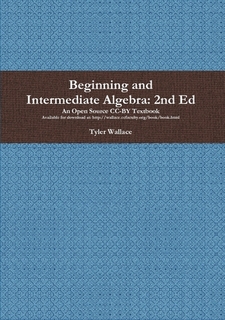
Beginning and Intermediate Algebra

Beginning and Intermediate Algebra was designed to reduce textbook costs to students while not reducing the quality of materials. This text includes many detailed examples for each section along with several problems for students to practice and master concepts. Complete answers are included for students to check work and receive immediate feedback on their progress.
Topics covered include: pre-algebra review, solving linear equations, graphing linear equations, inequalities, systems of linear equations, polynomials, factoring, rational expressions and equations, radicals, quadratics, and functions including exponential, logarithmic and trigonometric.
Each lesson also includes a World View Note which describes how the lesson fits into math history and into the world, including China, Russia, Central America, Persia, Ancient Babylon (present day Iraq) and more.
- PDF. A Portable Document Format (PDF) file is can be opened using the free Acrobat Reader. It is not an editable format.
- Chapter 0: Pre-Algebra
- 0.1 Integers
- 0.2 Fractions
- 0.3 Order of Operations
- 0.4 Properties of Algebra
- Chapter 1: Solving Linear Equations
- 1.1 One-Step Equations
- 1.2 Two-Step Equations
- 1.3 General Linear Equations
- 1.4 Solving with Fractions
- 1.5 Formulas
- 1.6 Absolute Value Equations
- 1.7 Variation
- 1.8 Application: Number/Geometry
- 1.9 Application: Age
- 1.10 Application: Distance
- Chapter 2: Graphing
- 2.1 Points and Lines
- 2.2 Slope
- 2.3 Slope-Intercept Form
- 2.4 Point-Slope Form
- 2.5 Parallel & Perpendicular Lines
- Chapter 3: Inequalities
- 3.1 Solve and Graph Inequalities
- 3.2 Compound Inequalities
- 3.3 Absolute Value Inequalities
- Chapter 4: Systems of Equations
- 4.1 Graphing
- 4.2 Substitution
- 4.3 Addition/Elimination
- 4.4 Three Variables
- 4.5 Application: Value Problems
- 4.6 Application: Mixture Problems
- Chapter 5: Polynomials
- 5.1 Exponent Properties
- 5.2 Negative Exponents
- 5.3 Scientific Notation
- 5.4 Introduction to Polynomials
- 5.5 Multiply Polynomials
- 5.6 Multiply Special Products
- 5.7 Divide Polynomials
- Chapter 6: Factoring
- 6.1 Greatest Common Factor
- 6.2 Grouping
- 6.3 Trinomials where a=1
- 6.4 Trinomials where a _1
- 6.5 Factoring Special Products
- 6.6 Factoring Strategy
- 6.7 Solve by Factoring
- Chapter 7: Rational Expressions
- 7.1 Reduce Rational Expressions
- 7.2 Multiply and Divide
- 7.3 Least Common Denominator
- 7.4 Add and Subtract
- 7.5 Complex Fractions
- 7.6 Proportions
- 7.7 Solving Rational Equations
- 7.8 Application: Dimensional Analysis
- Chapter 8: Radicals
- 8.1 Square Roots
- 8.2 Higher Roots
- 8.3 Adding Radicals
- 8.4 Multiply and Divide Radicals
- 8.5 Rationalize Denominators
- 8.6 Rational Exponents
- 8.7 Radicals of Mixed Index
- 8.8 Complex Numbers
- Chapter 9: Quadratics
- 9.1 Solving with Radicals
- 9.2 Solving with Exponents
- 9.3 Completing the Square
- 9.4 Quadratic Formula
- 9.5 Build Quadratic from Roots
- 9.6 Quadratic in Form
- 9.7 Application: Rectangles
- 9.8 Application: Teamwork
- 9.9 Simultaneous Products
- 9.10 Application: Revenue and Distance
- 9.11 Graphs of Quadratics
- Chapter 10: Functions
- 10.1 Function Notation
- 10.2 Operations on Functions
- 10.3 Inverse Functions
- 10.4 Exponential Functions
- 10.5 Logarithmic Functions
- 10.6 Application: Compound Interest
- 10.7 Trigonometric Functions
- 10.8 Inverse Trigonometric Functions
- Student Solutions Manual. Worked out solutions for selected exercises
- MyOpenMath / Lumen OHM online homework. MyOpenMath is a free online homework system, built on the open source IMathAS assessment platform.
It provides randomized, algorithmically generated homework with automated grading of numerical and algebraic answers, similar to WebAssign and MyMathLab.
It also provides a course management system with gradebook, file posting, discussion forums, etc.
Assessment sets have been created for this textbook, which may be available for self-study by students, or can copied as a starter course shell by faculty.
MyOpenMath use is free with community support through forums. For Washington State faculty, the WAMAP.org site also mirrors this content.
Lumen OHM is a commercial alternative to MyOpenMath that provides support for faculty and large scale adoption and administration, service level agreements, and additional curated course bundles. - Videos. See the comments below for details.
- CourseWare package. Courseware packages typically include a course structure with syllabus, some form of homework assignments, and some type of assessments. They may also include: videos, lecture notes, handouts, worksheets, quizzes, etc. See comments below for details
There are videos for each section available. A courseware pack is available for MyOpenMath, which provides sequentially released exercise sets with summary assessments, providing a full self-guided learning setup.
There are workbooks available to accompany this book that are designed to accompany the author's video lectures. There is a workbook for the beginning algebra half that can be downloaded, and for the intermediate algebra half that can be downloaded.
There is also a student solutions manual that can be downloaded or purchased.
There is also a self-study course based on this text available on MyOpenMath for students studying on their own.